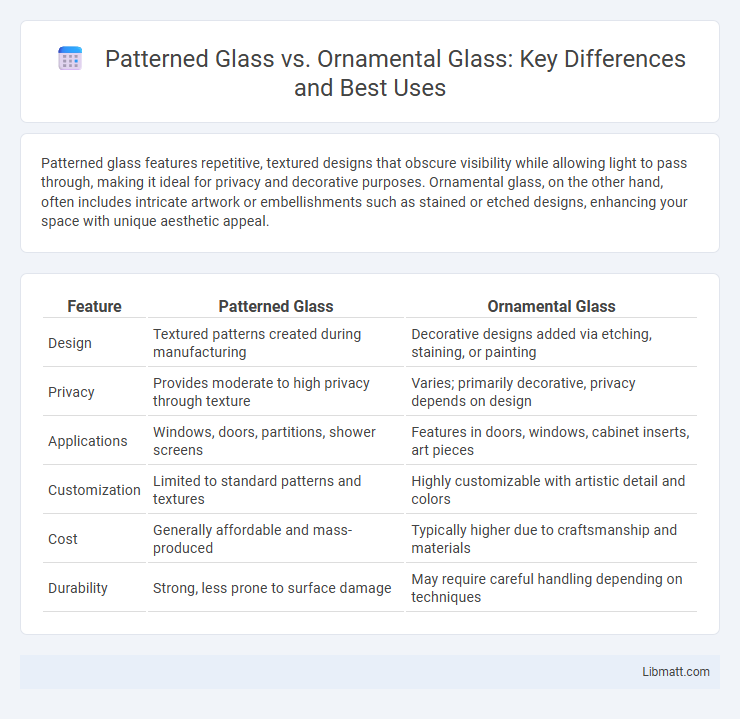Patterned glass features repetitive, textured designs that obscure visibility while allowing light to pass through, making it ideal for privacy and decorative purposes. Ornamental glass, on the other hand, often includes intricate artwork or embellishments such as stained or etched designs, enhancing your space with unique aesthetic appeal.
Table of Comparison
| Feature | Patterned Glass | Ornamental Glass |
|---|---|---|
| Design | Textured patterns created during manufacturing | Decorative designs added via etching, staining, or painting |
| Privacy | Provides moderate to high privacy through texture | Varies; primarily decorative, privacy depends on design |
| Applications | Windows, doors, partitions, shower screens | Features in doors, windows, cabinet inserts, art pieces |
| Customization | Limited to standard patterns and textures | Highly customizable with artistic detail and colors |
| Cost | Generally affordable and mass-produced | Typically higher due to craftsmanship and materials |
| Durability | Strong, less prone to surface damage | May require careful handling depending on techniques |
Introduction to Patterned Glass and Ornamental Glass
Patterned glass features textured surfaces created through rolling or pressing techniques, providing privacy while allowing light transmission. Ornamental glass encompasses a broader category, including stained, etched, or decorative designs that enhance aesthetic appeal and architectural detail. Both types serve functional and decorative purposes but differ in texture complexity and visual impact.
Defining Patterned Glass
Patterned glass features repetitive, textured designs pressed into the glass surface to enhance privacy and diffuse light while maintaining visibility. Ornamental glass, in contrast, includes decorative elements such as etching, staining, or intricate motifs, serving primarily aesthetic purposes. When selecting between patterned and ornamental glass, your choice depends on whether privacy or artistic detail is the primary requirement.
Understanding Ornamental Glass
Ornamental glass features intricate designs and textures created through processes such as etching, engraving, or sandblasting, enhancing both aesthetic appeal and privacy. Unlike patterned glass, which relies on repetitive patterns pressed or rolled into the glass during manufacturing, ornamental glass offers more custom and artistic expressions suitable for decorative applications in doors, windows, and partitions. Understanding ornamental glass involves recognizing its versatility in interior design and its role in diffusing light while adding elegance and character to architectural spaces.
Key Differences Between Patterned and Ornamental Glass
Patterned glass features repetitive textures or designs primarily for privacy and light diffusion, whereas ornamental glass includes intricate, artistic motifs often used for decorative purposes. Patterned glass is typically manufactured through rolling or pressing methods to create consistent patterns, while ornamental glass may involve techniques like etching, staining, or engraving to achieve detailed aesthetics. The functional focus of patterned glass centers on obscuring visibility and enhancing light transmission, contrasted with ornamental glass's emphasis on visual appeal and architectural embellishment.
Aesthetic Appeal and Design Options
Patterned glass offers consistent, repetitive textures that enhance privacy while allowing light to pass through, making it ideal for modern spaces seeking subtle decorative effects. Ornamental glass provides intricate, artistic designs with varied patterns and colors, creating a focal point that adds character and elegance to your interiors. You can choose patterned glass for minimalistic aesthetics or ornamental glass for a more elaborate, customized look to elevate your design scheme.
Privacy and Light Transmission
Patterned glass offers enhanced privacy by incorporating textured or embossed designs that obscure visibility while allowing natural light to pass through effectively. Ornamental glass, often featuring decorative elements like etched or stained patterns, balances aesthetic appeal with varying degrees of light transmission depending on the density and style of decoration. Your choice between patterned and ornamental glass should consider the desired level of privacy alongside the amount of natural light you want to maintain in your space.
Common Applications and Uses
Patterned glass is commonly used in office partitions, bathroom windows, and shower enclosures for privacy while allowing light transmission. Ornamental glass is often found in decorative doors, cabinet windows, and architectural accents to enhance aesthetic appeal with intricate designs. Both types serve functional and decorative purposes in residential and commercial interior design.
Durability and Maintenance Considerations
Patterned glass offers enhanced durability due to its textured surface, which is less prone to scratches and minor damages compared to ornamental glass, often crafted with delicate designs and embedded materials. Ornamental glass requires more careful maintenance to preserve its intricate details and finish, as harsh cleaning methods can cause wear or discoloration over time. When choosing between the two, consider Your environment and cleaning routine to ensure longevity and maintain aesthetic appeal.
Cost Comparison: Patterned vs. Ornamental Glass
Patterned glass typically costs less than ornamental glass due to its simpler manufacturing process and standardized designs, making it an economical choice for privacy and decorative applications. Ornamental glass involves intricate, hand-crafted details and unique artistic elements, which significantly increase production time and material costs. For projects with budget constraints, patterned glass offers a cost-effective solution, while ornamental glass provides premium aesthetics that justify its higher price point.
Choosing the Right Glass for Your Project
Patterned glass offers a variety of textured designs that enhance privacy and diffuse light, making it ideal for bathrooms or office partitions where subtle aesthetics are needed. Ornamental glass, often featuring intricate, artistic motifs or stained elements, elevates decorative appeal and serves as a focal point in entryways, cabinet doors, or feature walls. Selecting the right glass depends on balancing functional requirements like light transmission and privacy with the desired visual impact and architectural style of your project.
patterned glass vs ornamental glass Infographic

 libmatt.com
libmatt.com